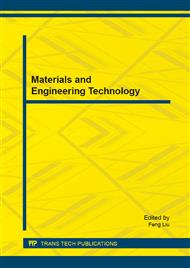[1]
A-L Barabási, The network takeover, Nature Physics, 8(1): 14, (2011).
Google Scholar
[2]
M. E.J. Newman, Networks: an introduction, Oxford University Press, (2010).
Google Scholar
[3]
L. Donetti and M. A. Munoz, Detecting network communities: a new systematic and efficient algorithm, Journal of Statistical Mechanics: Theory and Experiment, 2004(10): P10012, (2004).
DOI: 10.1088/1742-5468/2004/10/p10012
Google Scholar
[4]
F. D. Malliaros and M. Vazirgiannis, Clustering and community detection in directed networks: A survey, Physics Reports, 533(4): 95–142, (2013).
DOI: 10.1016/j.physrep.2013.08.002
Google Scholar
[5]
L. Hong, S. M. Cai, J. Zhang, Z. Zhuo, Z. Q. Fu, and P. L. Zhou, Synchronization-based approach for detecting functional activation of brain, Chaos: An Interdisciplinary Journal of Nonlinear Science, 22(3): 033128, (2012).
DOI: 10.1063/1.4747710
Google Scholar
[6]
S. Fortunato, Community detection in graphs, Physics Reports, 486(3): 75–174, (2010).
Google Scholar
[7]
M. Coscia, F. Giannotti, and D. Pedreschi, A classification for community discovery methods in complex networks, Statistical Analysis and Data Mining, 4(5): 512–546, (2011).
DOI: 10.1002/sam.10133
Google Scholar
[8]
M. E. J. Newman and M. Girvan, Finding and evaluating community structure in networks, Physical review E, 69(2): 026113, (2004).
Google Scholar
[9]
Y. Y. Ahn, J. P. Bagrow and S. Lehmann, Link communities reveal multiscale complexity in networks, Nature, 466(7307): 761–764, (2010).
DOI: 10.1038/nature09182
Google Scholar
[10]
C. Böhm, C. Plant, J. Shao, and Q. Yang, Clustering by synchronization, In Proceedings of the 16th ACM SIGKDD international conference on Knowledge discovery and data mining, pages 583–592, ACM, (2010).
DOI: 10.1145/1835804.1835879
Google Scholar
[11]
A. Capocci, V. D. P. Servedio, G. Caldarelli and F. Colaiori, Detecting communities in large networks, Physica A: Statistical Mechanics and its Applications, 352(2): 669–676, (2005).
DOI: 10.1016/j.physa.2004.12.050
Google Scholar
[12]
A. Arenas, A. Diaz-Guilera, J. Kurths, Y. Moreno, and C. S. Zhou, Synchronization in complex networks, Physics Reports, 469(3): 93–153, (2008).
DOI: 10.1016/j.physrep.2008.09.002
Google Scholar
[13]
J. Leskovec, K. J. Lang, A. Dasgupta, and M. W Mahoney, Community structure in large networks: Natural cluster sizes and the absence of large well-defined clusters, Internet Mathematics, 6(1): 29–123, (2009).
DOI: 10.1080/15427951.2009.10129177
Google Scholar
[14]
S. Chauhan, M. Girvan and E. Ott, Spectral properties of networks with community structure, Physical Review E, 80(5): 056114, (2009).
DOI: 10.1103/physreve.85.029906
Google Scholar
[15]
Information on http: /snap. stanford. edu/data.
Google Scholar


